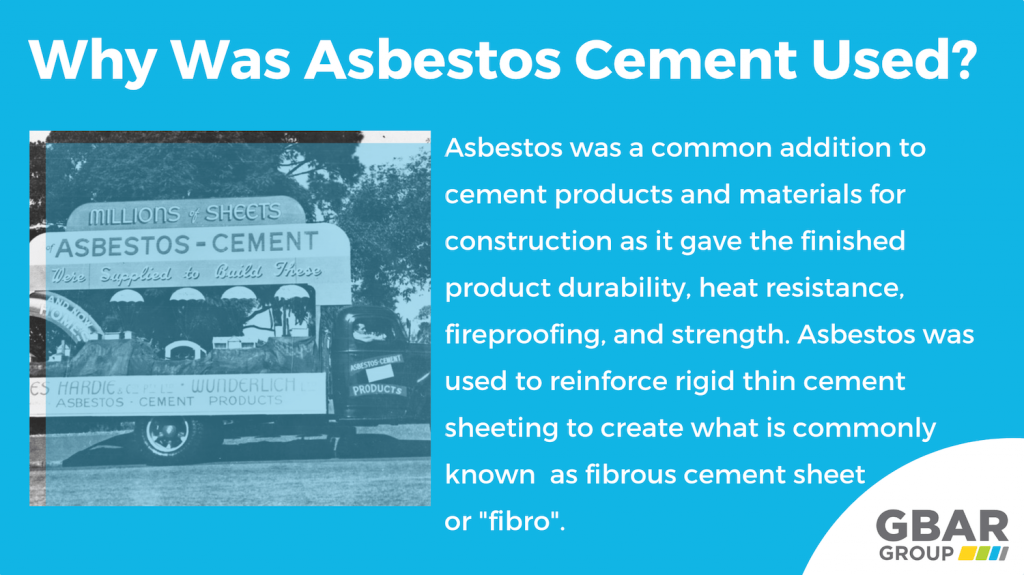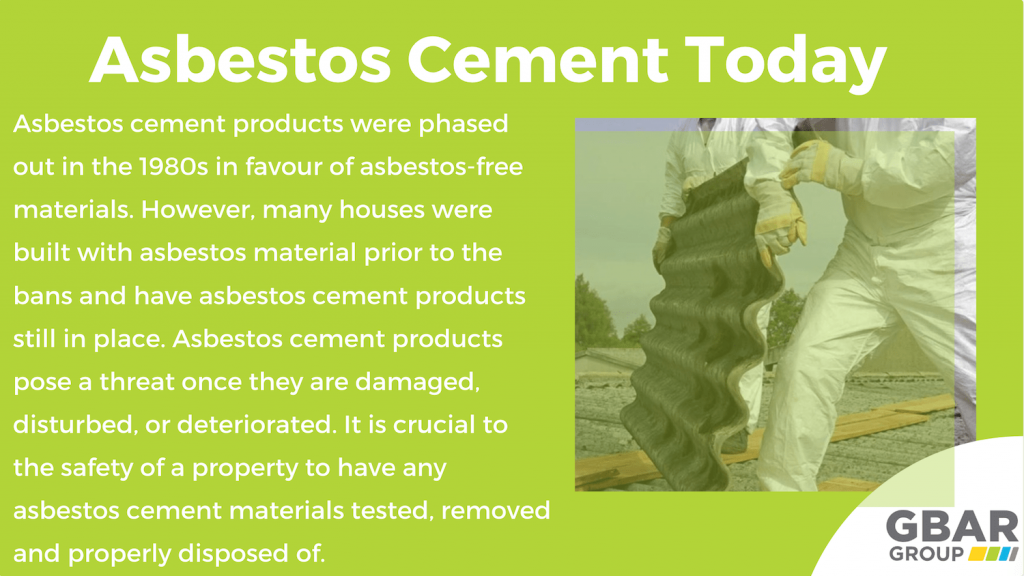
The use of asbestos in concrete products has changed dramatically over the last two decades. Find out the critical difference between asbestos and non-asbestos cement and how regulations have evolved over the years.
In Australia, it is estimated that over 60% of all production and 90% of all consumption of asbestos fibres occurred in the asbestos cement manufacturing industry. For much of the 20th century, asbestos cement sheets provided the construction industry with a rugged solution for roofing, siding, and foundation projects.
Fibre Reinforced Cement or “fibro” was the most common composite building and construction material with added asbestos. Asbestos fibres were used to reinforce thin cement sheets while simultaneously providing the finished product with the added benefits of fire resistance, insulation, and increased durability.
Asbestos was a common addition to cement products and materials until the increased awareness of the toxicity of asbestos fibres. Up until the 1980s, asbestos cement products were probably the most widespread and popular materials for both domestic and commercial construction in Australia. WorkSafe Australia estimates that almost all houses built before 1990 are likely to contain asbestos cement products in some form or another.
By the 1980s, asbestos cement products were phased out in favour of asbestos-free products. In 2003, Australia finally saw the official ban on the use, importation, manufacturing of and selling of asbestos fibres. Today, the true cost of asbestos products has emerged in the form of the prevalence of asbestos-related illnesses.

What is Asbestos Cement?
Asbestos cement was a product used widely across Australia for concrete construction and manufacturing. Asbestos cement products are bonded cement-based materials that were heavily used in construction. Asbestos cement is made up of a mixture of cement, sand, and asbestos fibres for added strength and durability.
Fibro asbestos products are building materials in which asbestos fibres are used to reinforce thin rigid cement sheets. Originally advertised as a fireproof, durable and affordable building product, asbestos cement first became very popular in the 1940s.
Asbestos fibres were well mixed in with cement products and bound together so they could form any shape the wet cement would allow. As the asbestos was sealed in with the concrete, it is classed as non-friable asbestos. Non-friable asbestos poses an exposure threat when the product becomes disturbed, damaged or deteriorated. Today, modern-day fibro materials are asbestos-free and are reinforced with alternatives, such as cellulose.
Where Can I Find Asbestos in Concrete?

Thin Asbestos Cement Sheet: Asbestos in cement walls both on exteriors and interiors of houses are made from asbestos cement boards or flat sheets. Commonly known as fibro, asbestos cement boards were thin sheets used for cladding, waterproofing, and to line eaves.
Corrugated Asbestos Cement: Asbestos cement corrugated sheets were used for roofing and cladding on commercial, industrial and domestic properties. Asbestos corrugated cement materials are recognizable by their very deep ridges or corrugations. By the 1980s, corrugated asbestos roofing was phased out in favour of asbestos-free roofing materials.
Compressed Asbestos Cement Board: Asbestos in concrete blocks or “thick” asbestos cement boards were commonly used as an outdoor material, and can be found on veranda decks and steps, outdoor paths, and even shower and bathroom cubicles. Asbestos concrete blocks are usually at least 2cm thick, very hard, heavy, and durable.
Asbestos Cement Products: Asbestos cement was used in the manufacturing of common roofing materials including guttering, downpipes, roof ridges, wall capping, cover stripping, and fascia.
Asbestos Cement Pipes: Asbestos cement pipes were commonly used for stormwater, downpipes, drinking water, sewage, and irrigation.
Asbestos Cement Flues: Asbestos cement flues were used on heaters, boilers, stoves and hot water services. Asbestos flues can be found around hot water services, in-ceiling cavities, and on building exteriors running up the walls and above the roof.
The Difference Between Asbestos and Non-Asbestos Cement
Today, cement boarding, corrugated roofing, and fibro cement sheeting are all manufactured and used in construction without any asbestos. Cellulose fibres are now frequently used instead of asbestos materials for cement reinforcement. Asbestos has not been used in domestic building materials since the 1980s. Ever since the official ban on all asbestos products in 2003, it has been illegal to sell, buy, manufacture, import, and transport any form of asbestos.

Deciphering the difference between asbestos and non-asbestos cement sheets is very difficult to do visually. With many asbestos products and materials, it can sometimes be possible to visually identify asbestos fibres by their characteristically long, thin, fibre ends. However, asbestos cement products were tightly bound and mixed, so the asbestos fibres are sealed in with the concrete.
The only way to be certain of the presence or absence of asbestos in cement is to have a sample of the material analysed by a laboratory. Asbestos cement products cannot be positively identified without an asbestos specialist present. If you have found or suspect that your home is contaminated with asbestos, it is best to consult with a professional asbestos abatement company to discuss your options.
GBAR Group is the leading expert in asbestos testing, removal, and safe disposal. Accredited nation-wide, GBAR has been removing asbestos and keeping properties safe from asbestos contamination for over 15 years now. Their experience, training, and in-depth knowledge of the dangers of asbestos provide an elite asbestos removal service that guarantees safety for the entire property. Don’t run the risk of being exposed to asbestos – call the professionals at GBAR Group Australia.






